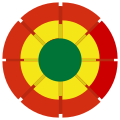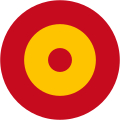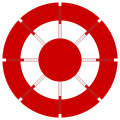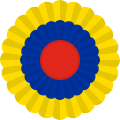Cockade
The cockade or cockarda is a national symbol in many countries. It consists of a fabric rose window superimposed on an inverted V-shaped loop, the ends of which exceed the diameter of the rose window. The ribbon with which both the rosette and the bow are made must have the same colors as the national flag of the country it represents. Currently it also has a practical use, for example, in war planes; painted on the dorsal to distinguish the national flag to which each device belongs, it is called aeronautical cockade.
Origin
The cockade was the currency composed of ribbons of one or more colors made in the shape of a rose or bow, which was put on the hat and served, among other things, to distinguish between the different armies and nations and to recognize those of a faction or side in the various parties that were formed on some political issue. This was also the name given to the folded or rolled ribbon worn by knights in tournaments and which is still represented on shields today.
Country cockade
Argentinian Cockade
The cockade is one of the national symbols of Argentina. Established by a decree of May 18, 1812 of the First Triumvirate, it is considered the first national symbol of the Republic, preceding the other three national emblems -them being the flag, the shield, and the anthem-.
The origin of the colors of the cockade and the reasons why they were chosen to symbolize the Homeland cannot be established with precision. Although its use is not restricted to any part of the year in particular, the cockade sees greater use during the Week of May, which begins with the celebration of the National Cockade Day, on the 18th, and culminates with the commemoration of the Revolution of May 25, 1810. It can also be seen to a lesser extent during other national holidays and military parades.
The first approximate date of the use of the current Argentine national colors is May 19, 1810, when they were used by a group of women who met with Colonel Cornelio Saavedra. On March 23, 1811, the cockade was used as a badge of opponents of the majority of the Junta Grande. On February 13, 1812, Manuel Belgrano -by means of a note- requested the Triumvirate to establish the use of the national cockade. Finally, on February 18, 1812, the power constituted by the Triumvirate informed the Chief of the Major Army that: "the government has resolved that the National Cockade of the Provinces be recognized and used by the troops United Nations of the Río de la Plata, which must be made up of two colors, white and light blue, being abolished from this date the red that used to be distinguished".
Bolivian Cockade
The cockade is a national emblem of Bolivia. It is used by the citizens of that country during parades and civic acts, being more used in the national month (August). It is carried on the left chest as an individual representation. The colors of the cockade refer to the Bolivian flag, ordered as follows: red on the outer edge, yellow on the central band, and green on the inside. Sometimes it is usually used with two ribbons at the bottom of the cockade, also using the national colors.
Brazilian Cockade
Chile Cockade
The cockade or cucarda is one of the national symbols of Chile. Together with the flag and the national shield, it was declared a national emblem by Supreme Decree on October 18, 1967. Later, the cockade lost its status as a national emblem with the drafting of the Political Constitution of the Republic of Chile (1980 and its modifications). The emblem, originally made of cloth, has turquoise blue in the center, white in the second stripe and red on the outside, with a silver star in the blue center.
Colombian Cockade
Ecuador cockade
Spanish cockade
The cockade as a national symbol appears with the War of Independence, and is initially red, like the one worn by the military since the XVII. At the end of the XIX century, it was replaced by a bicolor cockade imitating the colors of the national flag. The cockade in Spain is circular, with three red, yellow and red rings. It is exhibited as an individual representation in the event of distinctions or prizes or for other types of events, and it is also an identifying mark for all Spaniards.
Netherlands Cockade
Paraguayan Cockade
The cockade is an emblem of Paraguay that symbolizes the national colors red, white and blue. The time when the Paraguayan cockade is most used is during Independence week, which is celebrated on May 14 of each year.
Peruvian Cockade
The cockade is a national emblem of Peru. The colors of the ribbon of this cockade have the same arrangement as those of the national flag. It has two variants, one without the two tapes, and another that does have them. It is commonly used pinned, as a badge, on the left side of the chest throughout the month of July.
Uruguay Cockade
The cockade is one of the national symbols of Uruguay. Recognized by the Law of December 22, 1828, it has the colors of the National Pavilion. The one used from then until the law that defines the current national cockades was light blue, as seen on the Coat of Arms of Uruguay, tying the olive and laurel branches:
"Dicho ovalo will be pegged by two branches of olive and laurel joined at the base by a loop, blue sky"
Light blue continued to be the color that defined the Centralized State, or its supporters. In this way, during the Great War, Fructuoso Rivera's troops used the national flag with very pale blue stripes, while those of Manuel Oribe used very dark blue. Currently, "la Celeste" It is the jacket used by the national soccer team, as well as its pseudonym. On July 10, 1916, the current ones were regulated. The one for civil use has four stripes with the sky-blue of the National Flag, its use being freely permitted to citizens. The variation (approved by Law 5,458 of July 10, 1916), for the exclusive use of the Army, the Navy and the Air Force of the Republic.
Venezuelan Cockade
The first Venezuelan cockade or cocarda was approved by the First National Congress in the session of July 9, 1811, the same day the Flag was approved National. The Executive Power of that time ordered that it be used by the citizens of the Venezuelan Confederation. The 1811 version ordered the insignia as follows: "...sky blue colors in the center, yellow and red on the circumferences...". Currently it does not have the status of national symbol and the logical ordering of its colors has changed.












